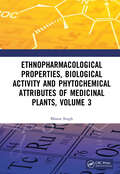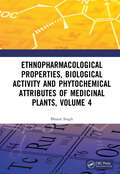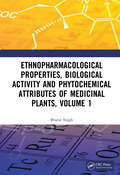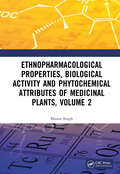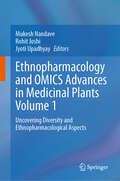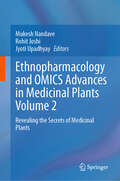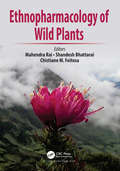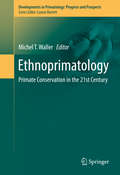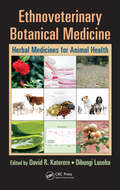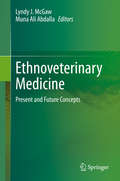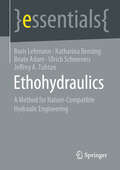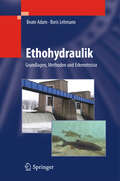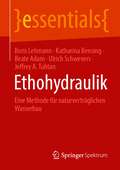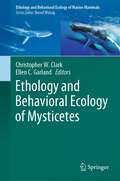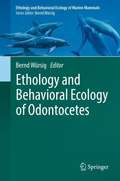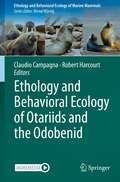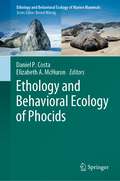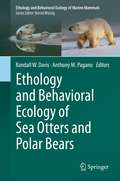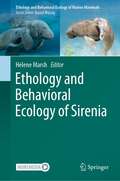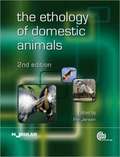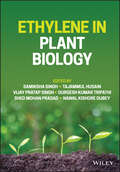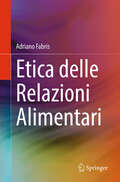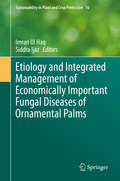- Table View
- List View
Ethnopharmacological Properties, Biological Activity and Phytochemical Attributes of Medicinal Plants Volume 3
by Bharat SinghThis book covers the morphological characteristics, ethnopharmacological properties, isolated and identified structurally diverse secondary metabolites, biological and pharmacological activities of medicinal plants. Ethnopharmacology is the systematic study of folklore/traditional medicines, which continue to provide innovative drugs and lead molecules for the pharmaceutical industry. In fact, plant secondary metabolites, used as a single molecule or as a mixture, are medicines that can be effective and safe even when synthetic drugs fail. Therefore, the description of these secondary metabolites as well as methods for the targeted expression and/or purification is of high interest. In addition to surveying the morphological features, ethnopharmacological properties, biological and pharmacological activities, and studies of clinical trials, this book offers a comprehensive treatment of 56 plant species. It also presents the cell culture conditions and various methods used for increasing the production of medicinally important secondary metabolites in plant cell cultures. This volume: · Provides the morphological features, habitat, and distribution of each species of 56 genera selected from the different regions of the world. · Presents ethnopharmacological applications of various species of included 56 genera of this book. Different species of 56 genera are used for ethnomedicinal uses by the people of various countries of the world. · Describes structures of various secondary metabolites identified in 56 plant species together with their biological and pharmacological activities. · Discusses strategies of secondary metabolites production, such as organ culture, pH, elicitation, hairy root cultures, light, and mutagenesis. · Provides a complete overview of each species of 56 genera and complete information up to year 2022. Ethnopharmacological Properties, Biological Activity and Phytochemical Attributes of Medicinal Plants is an important book for undergraduate and postgraduate students, pharmacologists, phytochemists, Ayurvedic practitioners, medical doctors, and biotechnologists interested in the ethnopharmacological properties, phytochemistry, and biological and pharmacological activities of plants.
Ethnopharmacological Properties, Biological Activity and Phytochemical Attributes of Medicinal Plants Volume 4
by Bharat SinghThis book covers the morphological characteristics, ethnopharmacological properties, isolated and identified structurally diverse secondary metabolites, biological and pharmacological activities of medicinal plants. Ethnopharmacology is the systematic study of folklore/traditional medicines, which continue to provide innovative drugs and lead molecules for the pharmaceutical industry. In fact, plant secondary metabolites, used as a single molecule or as a mixture, are medicines that can be effective and safe even when synthetic drugs fail. Therefore, the description of these secondary metabolites as well as methods for the targeted expression and/or purification is of high interest. In addition to surveying the morphological features, ethnopharmacological properties, biological and pharmacological activities, and studies of clinical trials, this book offers a comprehensive treatment of 56 plant species. It also presents the cell culture conditions and various methods used for increasing the production of medicinally important secondary metabolites in plant cell cultures. This volume: Provides the morphological features, habitat, and distribution of each species of 56 genera selected from the different regions of the world. Presents ethnopharmacological applications of various species of the 56 genera in this book. Different species of 56 genera are used for ethnomedicinal uses by the people of various countries of the world. Describes structures of various secondary metabolites identified in 56 plant species together with their biological and pharmacological activities. Discusses strategies of secondary metabolites production, such as organ culture, pH, elicitation, hairy root cultures, light, and mutagenesis. Provides a complete overview of each species of 56 genera and the complete information up to 2022. Ethnopharmacological Properties, Biological Activity and Phytochemical Attributes of Medicinal Plants is an important book for undergraduate and postgraduate students, pharmacologists, phytochemists, Ayurvedic practitioners, medical doctors, and biotechnologists interested in the ethnopharmacological properties, phytochemistry, biological, and pharmacological activities of plants.
Ethnopharmacological Properties, Biological Activity and Phytochemical Attributes of Medicinal Plants, Volume 1
by Bharat SinghThis book covers the morphological characteristics, ethnopharmacological properties, isolated and identified structurally diverse secondary metabolites, biological and pharmacological activities of medicinal plants. Ethnopharmacology is the systematic study of folklore/traditional medicines, which continue to provide innovative drugs and lead molecules for the pharmaceutical industry. In fact, plant secondary metabolites, used as a single molecule or as a mixture, are medicines that can be effective and safe even when synthetic drugs fail. Therefore, the description of these secondary metabolites as well as methods for the targeted expression and/or purification is of high interest. In addition to surveying the morphological features, ethnopharmacological properties, biological and pharmacological activities, and studies of clinical trials, this book offers a comprehensive treatment of 56 plant species. It also presents the cell culture conditions and various methods used for increasing the production of medicinally important secondary metabolites in plant cell cultures. This volume: · Provides the morphological features, habitat, and distribution of each species of 56 genera selected from the different regions of the world. · Presents ethnopharmacological applications of various species of the 56 genera included in this book. Different species of 56 genera are used for ethnomedicinal uses by the people of various countries of the world. · Describes structures of various secondary metabolites identified in 56 plant species together with their biological and pharmacological activities. · Discusses strategies of secondary metabolites production, such as organ culture, pH, elicitation, hairy root cultures, light, and mutagenesis. · Provides a complete overview of each species of 56 genera and complete information up to 2022. Ethnopharmacological Properties, Biological Activity and Phytochemical Attributes of Medicinal Plants is an important book for undergraduate and postgraduate students, pharmacologists, phytochemists, Ayurvedic practitioners, medical doctors, and biotechnologists interested in the ethnopharmacological properties, phytochemistry, and biological and pharmacological activities of plants.
Ethnopharmacological Properties, Biological Activity and Phytochemical Attributes of Medicinal Plants, Volume 2
by Bharat SinghThis book covers the morphological characteristics, ethnopharmacological properties, isolated and identified structurally diverse secondary metabolites, biological and pharmacological activities of medicinal plants. Ethnopharmacology is the systematic study of folklore/traditional medicines, which continue to provide innovative drugs and lead molecules for the pharmaceutical industry. In fact, plant secondary metabolites, used as a single molecule or as a mixture, are medicines that can be effective and safe even when synthetic drugs fail. Therefore, the description of these secondary metabolites as well as methods for the targeted expression and/or purification is of high interest. In addition to surveying the morphological features, ethnopharmacological properties, biological and pharmacological activities, and studies of clinical trials, this book offers a comprehensive treatment of 56 plant species. It also presents the cell culture conditions and various methods used for increasing the production of medicinally important secondary metabolites in plant cell cultures. This volume: · Provides the morphological features, habitat, and distribution of each species of 56 genera selected from the different regions of the world. · Presents ethnopharmacological applications of various species of the 56 genera included in this book. Different species of 56 genera are used for ethnomedicinal uses by the people of various countries of the world. · Describes structures of various secondary metabolites identified in 56 plant species together with their biological and pharmacological activities. · Discusses strategies of secondary metabolites production, such as organ culture, pH, elicitation, hairy root cultures, light, and mutagenesis. · Provides a complete overview of each species of 56 genera and complete information up to 2022. Ethnopharmacological Properties, Biological Activity and Phytochemical Attributes of Medicinal Plants is an important book for undergraduate and postgraduate students, pharmacologists, phytochemists, Ayurvedic practitioners, medical doctors, and biotechnologists interested in the ethnopharmacological properties, phytochemistry, and biological and pharmacological activities of plants.
Ethnopharmacology and Drug Discovery for COVID-19: Anti-SARS-CoV-2 Agents from Herbal Medicines and Natural Products
by Jen-Tsung ChenThis book presents a complete overview of COVID-19 and provides a series of in-depth analyses of the literature and a comprehensive discussion and perspectives on promising anti-SARS-CoV-2 agents based on the system of ethnopharmacology, which covers Chinese medicine, traditional medicines of India and Africa, Turkish folk medicine, essential oils, and some well-known medicinal plants. In this book, the current status of therapeutic strategies against COVID-19 was summarized and a perspective of potential options for the future was proposed. Based on ethnopharmacology, some well-established traditional herbal formulations and bioactive compounds with anti-virus activity were repurposed for managing COVID-19 and post-illness, including neurological disorders and kidney illness. Using drug discovery tools, promising immune enhancers were explored from phytochemicals against SARS-CoV-2. Nutraceuticals from dietary plants, spices, and fruits with anti-virus and antioxidant activities were recommended to prevent infection or severe illness caused by emerging variants. With the aid of systems pharmacology, researchers have gained insights into possible molecular mechanisms of anti-SARS-CoV-2 activity and have predicted a range of candidate compounds from medicinal plants to combat COVID-19. This book explores the current knowledge of drug discovery and ethnopharmacology for managing coronavirus diseases. The content proved the anti-SARS-CoV-2 activity from natural products and traditional herbal medicines. It contributes to the management of global public health and fits the goal of establishing “Good Health and Well-Being,” which is one of “The Sustainable Development Goals (SDGs) 2030".
Ethnopharmacology and OMICS Advances in Medicinal Plants Volume 1: Uncovering Diversity and Ethnopharmacological Aspects
by Mukesh Nandave Rohit Joshi Jyoti UpadhyayThe book explores the world of medicinal plants through a groundbreaking and comprehensive book. It delves into high-throughput technologies and multi-omics approaches to unlock the untapped potential of endophytic fungi, revealing novel bioactive compounds. It further talks about the diverse biodiversity and ethnopharmacological knowledge, unravelling the molecular intricacies of secondary metabolites under varying ecological conditions. This gives insights into medicinal plant research, offering cutting-edge insights into genome-based barcoding, nanotechnology, and functional genomics for revolutionary drug discoveries. From proteomic and epigenomic analysis to big data exploration, this book presents a holistic view of medicinal plants' potential and discusses the latest advancements in micropropagation, agronomical approaches, and genome editing, paving the way for transformative medicines and healthcare breakthroughs.It serves as a great resource for academicians, researchers, and pharmacologists.
Ethnopharmacology and OMICS Advances in Medicinal Plants Volume 2: Revealing the Secrets of Medicinal Plants
by Mukesh Nandave Rohit Joshi Jyoti UpadhyayThis book delves into diverse facets and applications of medicinal plants. It discusses the metabolic, transcriptomic, and genomic intricacies of medicinal plants, shedding light on their chemical compositions, genetic makeup, and regulatory mechanisms. It includes a chapter on nanotechnology, investigating the influence of nanoparticles on medicinal plants. Subsequent chapters explore functional genomics and genome editing, showcasing innovative approaches to modifying plant genetics. It also discusses plant-associated microorganisms in the microbiome and endophytic fungi. Furthermore, the book addresses the critical issues of genetic diversity, agrotechnology for sustainable production, intellectual property rights, and the impact of various stresses on medicinal plants. This book serves as a valuable resource for researchers, educators, and students of pharmacology, offering a comprehensive understanding of medicinal plants and their evolving role in science and medicine.
Ethnopharmacology of Wild Plants
by Mahendra Rai; Shandesh Bhattarai; Chistiane M. FeitosaThe book provides valuable information on wild plants and their ethnopharmacological properties, discussion on ethnobotany, phytotherapy, diversity, chemical and pharmacological properties including antifungal, anti-inflammatory and antiprotozal properties. The chapters include a wide range of case studies, giving updated evidence on importance of wild plant resources from different countries including Nepal, India, Brazil, Chile, Argentina, Colombia, Egypt, Peru, etc. In addition, some specific species are used to explain their potential properties. Discussing traditional usage and pharmacological properties of wild plants, this book is entirely different from other related publications and useful for the researchers working in the areas of conservation biology, botany, ethnobiology, ethnopharmacology, policy making, etc.
Ethnoprimatology
by Michel T. WallerThe list of challenges facing nonhuman primates in the 21st century is a long one. The expansion of palm oil plantations to feed a growing consumer class is eating away at ape and monkey habitats in Southeast Asia and Central Africa. Lemurs are hunted for food in the poorest parts of Madagascar while monkeys are used as medicine in Brazil. Traditional cultural beliefs are maintaining demand for animal body parts in West African markets while viral YouTube videos of "cute" and "cuddly" lorises have increased their market value as pets and endangered their populations. These and other issues are addressed in this book by leading researchers in the field of ethnoprimatology, the study of human/nonhuman primate interactions that combines traditional primatological methodologies with cultural anthropology in an effort to better understand the nuances of our economic, ritualistic, and ecologic relationships.
Ethnoveterinary Botanical Medicine: Herbal Medicines for Animal Health
by David R. Katerere Dibungi LusebaDespite the undoubted success of a scientific approach to pharmaceuticals, the last few decades have witnessed a spectacular rise in interest in herbal medicinal products. This general interest has been followed by increasing scientific and commercial attention that led to the coining of the term ethnopharmacology to describe the scientific discipl
Ethnoveterinary Medicine: Present and Future Concepts
by Lyndy J. McGaw Muna Ali AbdallaThe importance of a complementary approach to animal health is highlighted in this book, with core themes encompassing reviews of traditional veterinary medicine for common diseases afflicting livestock, as well as local practices in different areas of the world. The book includes chapters on ethnoveterinary medicine used to prevent and treat ticks and tick-borne diseases, infectious diseases and parasites. Ethnoveterinary practices in parts of the world which have not been comprehensively reviewed before are highlighted, including Estonia, Belarus and the Maghreb - the north-western tip of Africa. A fascinating account of African ethnoveterinary medicine and traditional husbandry practices is provided by a veteran in the field with a wealth of practical experience in the area. Neglected areas of research involve the relationship of ethnoveterinary medicine with environmental, ethical, cultural and gender aspects, and leading experts explore these issues.The book is intended to provide an informative compilation of current research and future prospects in ethnoveterinary medicine, which hopes to inform and encourage investigations in new directions. Sustainable development requires a concerted effort to combine indigenous knowledge systems with scientific research to improve animal health. This is the case not only in rural areas where access to orthodox veterinary health care may be limited, but also against the backdrop of antibiotic resistance and increased demand for alternative and complementary therapies to enhance the health of both production and companion animals. Students, academics and veterinary professionals will find this book a useful addition to knowledge on present and future aspects of ethnoveterinary research.
Ethohydraulics: A Method for Nature-Compatible Hydraulic Engineering (essentials)
by Beate Adam Boris Lehmann Ulrich Schwevers Katharina Bensing Jeffrey A. TuhtanEthohydraulics is the transdiscipline linking behavioural science (ethology) and flow behaviour (hydraulics). Ethohydraulic studies provide repeatable and scalable insights into the reactive behaviour of aquatic animals. The findings can be used to derive limits and guidelines as well as design specifications for the planning of hydraulic engineering facilities. In this essential book, the authors provide an overview of the fundamentals and methodological approaches of ethohydraulic investigations. In addition to real-world case studies, current developments and future advances are provided.This Springer essential is a translation of the original German 1ststedition essentials,Ethohydraulik by Boris Lehmann, published by Springer-Verlag GmbH Germany, part of Springer Nature in 2021. The translation was done with the help of artificial intelligence (machine translation by the service DeepL.com). A subsequent human revision was done primarily in terms of content, so that the book will read stylistically differently from a conventional translation. Springer Nature works continuously to further the development of tools for the production of books and on the related technologies to support the authors.
Ethohydraulik
by Beate Adam Boris LehmannUm Fließgewässer den Nutzungsansprüchen des Menschen anzupassen, sind unzählige Baumaßnahmen erforderlich. Um die Auswirkungen wasserbaulicher Aktivitäten auf die in Fließgewässern lebenden Tiere zu untersuchen, wurde die Ethohydraulik entwickelt. Sie beruht auf der Ethologie (Erforschung des Verhaltens von Tieren) und der Hydraulik (Lehre von den bewegten Flüssigkeiten). Die Autoren stellen die Grundlagen dieser Wissenschaftsdisziplin dar und liefern Regeln sowie Grenz- und Bemessungswerte für die wasserbauliche Praxis.
Ethohydraulik: Eine Methode für naturverträglichen Wasserbau (essentials)
by Beate Adam Boris Lehmann Ulrich Schwevers Katharina Bensing Jeffrey A. TuhtanEthohydraulik agiert an der Schnittstelle zwischen Verhaltensforschung (Ethologie) und dem Strömungsverhalten (Hydraulik). Ethohydraulische Untersuchungen helfen, das hydraulisch-reaktive Verhalten von Wassertieren zu verstehen. Aus den Befunden lassen sich Grenz- und Richtwerte sowie Gestaltungsvorgaben für die Planung wasserbaulicher Anlagen ableiten. In diesem essential geben die Autoren einen Überblick über die Grundlagen und methodischen Ansätze ethohydraulischer Untersuchungen. Zudem werden Einsatzbereiche und aktuelle Weiterentwicklungen aufgezeigt.
Ethology and Behavioral Ecology of Mysticetes (Ethology and Behavioral Ecology of Marine Mammals)
by Christopher W. Clark Ellen C. GarlandIn this book, an international team of leading marine mammal scientists, with a remarkably diverse set of backgrounds and areas of expertise, lead you through a synthesis of current knowledge on baleen whales. Baleen whales are the largest animals ever to have lived on this planet. They also have the lowest and most intense voices on Earth, most likely evolved to take advantage of ocean acoustic transmission conditions so as to be detectable across ocean basins. Some baleen whales can live to be 150-200 years old. They migrate many thousands of kilometers between feeding and breeding areas. They produce songs and calls that serve as behavioral foundations for establishing, maintaining and expanding their cultural identities. To conclude that we know the behavioral limits of these large brained, long-lived animals would be naïve. As baleen whale scientists, we are still beginning to comprehend the enormous complexities and natural histories of these remarkable animals.Today, the fact that whales sing is known throughout much of the world. This awareness started 50 years ago with the publication and popularization of a collection of humpback song recordings that motivated research into baleen whale behavioral ethology. In this book’s chapters, a reader’s experiences will stretch from learning about baleen whale laryngeal anatomy associated with their different voices to learning about the vast ocean areas over which their voices can be heard and the emerging complexities of their culturally defined societies. These are accompanied by chapters on the fundamental ethological contexts of socializing, migrating, and foraging. Two common themes permeate the book. One theme highlights the phenomenal increase in scientific knowledge achieved through technological advancements. The other theme recognizes the impacts of human-made activities on ocean acoustic environments and the resultant influences on the health and survival of individual whales and their populations. Although the book is intentionally ambitious in its scope, as scientists, we fully recognize that baleen whale science is still in its infancy. Many profound revelations await discovery by cohorts of young, multi-talented explorers, some of whom are stretching their wings in this volume and some of whom are reading these scientific stories for the first time.
Ethology and Behavioral Ecology of Odontocetes (Ethology and Behavioral Ecology of Marine Mammals)
by Bernd WürsigThis book concentrates on the marine mammalian group of Odontocetes, the toothed whales, dolphins, and porpoises. In 23 chapters, a total of 40 authors describe general patterns of ethological concepts of odontocetes in their natural environments, with a strong bent towards behavioral ecology. Examples are given of particularly well-studied species and species groups for which enough data exist, especially from the past 15 years. The aim is to give a modern flavor of present knowledge of ethology and behavior of generally large-brained behaviorally flexible mammals that have evolved quite separately from social mammals on land. As well, the plight of populations and species due to humans is described in multiple chapters, with the goal that an understanding of behavior can help to solve or alleviate at least some human-made problems.
Ethology and Behavioral Ecology of Otariids and the Odobenid (Ethology and Behavioral Ecology of Marine Mammals)
by Claudio Campagna Robert HarcourtThis book is focused on the marine mammalian groups the Otariidae and the Odobenidae, otherwise known as fur seals, sea lions and the walrus. In 30 chapters, more than 60 authors from 30 institutions and 13 nationalities, discuss a broad suite of topics from maternal care and mating behavior, through play, cognition and personality, to adaptation to life in the Anthropocene. The authors explore the behaviors that have allowed these semi-aquatic mammals to thrive in the marine realm. Many populations have recovered following historical decimation, with interesting evolutionary consequences which are explored. Detailed, selected, individual species descriptions are also provided, showcasing the behavioral diversity of this engaging, adaptive and highly successful group of marine mammals.
Ethology and Behavioral Ecology of Phocids (Ethology and Behavioral Ecology of Marine Mammals)
by Daniel P. Costa Elizabeth A. McHuronPhocid (or earless or true) seals are ecologically diverse, occupying habitats from the tropics to the poles in marine and freshwater and feeding on anything from tiny zooplankton to other marine mammals. There are 18 species of phocid seals, the smallest species (ringed seal) is more than 20 times smaller than the largest (southern elephant seal), with marked sexual dimorphism present in some species. This book examines the behavior, ecology, and physiology that allow phocid seals to inhabit such a wide range of habitats. The book is composed of 16 chapters written by 37 authors from 8 countries. The book first describes the general patterns of phocid behavior, followed by descriptions of what is known about well-studied species. We have taken a holistic approach, focusing not only on the behaviors themselves but also on the factors that constrain the expression of behavior and the proximate mechanisms driving behavior. In many cases, the chapters represent collaborations between well-established researchers and early-mid career individuals who bring new perspectives to help carry the field of phocid behavioral ecology well into the future.
Ethology and Behavioral Ecology of Sea Otters and Polar Bears (Ethology and Behavioral Ecology of Marine Mammals)
by Randall W. Davis Anthony M. PaganoSea otters and polar bears are carnivorous marine mammals that still resemble their terrestrial ancestors. Compared with Cetacea (whales and dolphins), Sirenia (dugongs and manatees), and Pinnipedia (seals, sea lions, and walrus), they are less adapted for an aquatic life and the most recently evolved among marine mammals. Sea otters are amphibious but seldom come ashore, and polar bears primarily occur on sea ice or along the shore. When at sea, both species spend most of their time swimming at the surface or making short, shallow dives when foraging or pursuing prey. Indeed, polar bears rarely pursue seals in water. Nevertheless, polar bears are powerful swimmers and will stalk seals from the water. As with many other large carnivores, they are solitary hunters. Although sea otters are gregarious and form aggregations at sea called rafts, they are primarily asocial. Except during mating, the principal interaction among sea otters occurs between a female and offspring during the six-month dependency period. In large carnivores (e.g., wolves and lions) that feed on ungulates, sociality and cooperation are favored because of the need to capture large prey and defend carcasses. Polar bears, which are the largest terrestrial carnivore, are solitary hunters of seals and are neither gregarious nor social. Males and females briefly associate during courtship and mating. During this time, males aggressively compete for females. At other times, males generally avoid each other except for aggregations of males that form while summering on land, and females with cubs avoid males, which are known for infanticide. As with sea otters, the interaction of polar bears outside of mating occurs between a female and her offspring during the 2-3 year dependency period. This interaction is critically important when altricial cubs are born in the winter den. This book provides new insight into the ethology and behavioral ecology of sea otters and polar bears. Each chapter reviews the discoveries of previous studies and integrates recent research using new techniques and technology. The authors also address historic and current anthropogenic challenges for their survival as climate change alters entire marine ecosystems.
Ethology and Behavioral Ecology of Sirenia (Ethology and Behavioral Ecology of Marine Mammals)
by Helene MarshDespite their rich fossil history, there are only four surviving species of sirenians or sea cows, the only fully aquatic herbivorous mammals. The three species of manatees and the dugong live in the coastal waters rivers and lakes of more than 80 tropical and subtropical countries and are all on the IUCN Red List of Threatened Species. This book examines sirenian conservation biology through the lens of their behavioral ecology and ethology. Sirenian feeding, diving, movement, social and reproductive behaviors are reviewed by an international team of scientists from eight countries, with an emphasis on data gathered in the past 15 years.
Ethology of Domestic Animals
by Per JensenModern farm environments are profoundly different from the natural habitats of the ancestors of today's farm animals, and through genetic selection, the appearance and behaviour of the animals themselves have also changed. However, the legacy of the ancestors is still obvious, and some apparently bizarre actions are only possible to understand in the light of the evolutionary history of the species. On the other hand, some of the behaviour we can observe in animals in a modern farm or in a laboratory are not part of the normal, species-specific behaviour at all. They may even indicate that the animal is under stress and that its welfare is poor. Distinguishing between these possibilities is one important goal for applied ethology. This revised and updated edition includes extended coverage of dog behaviour and human-animal interactions as well as novel and intriguing research findings. The issue of animal cognition, central to understanding welfare, has also received a more thorough examination.
Ethylene Signaling
by Brad M. Binder G. Eric SchallerThis volume provides a collection of protocols aimed toward the study of ethylene signaling in plants. Ethylene Signaling: Methods and Protocols is divided into three sections: ethylene biosynthesis, the signal transduction pathway, and the diverse ethylene responses of dicots and monocots. The chapters in section one discuss techniques for the measurement of activities related to the biosynthetic enzymes ACC synthase and ACC oxidase, the levels of ethylene synthesized by plants, and the treatment of plants with exogenous ethylene. Section two focuses on the analysis of the new membrane-associated proteins involved in the initial perception and transduction of the ethylene signal, such as ethylene receptors, CTR1, and EIN2. The third section covers assays applicable to dicots and monocots, including methods related to the roles of ethylene in germination, growth, abscission, abiotic stress, and defense. Section three also includes information on Arabidopsis mutants and the variety of chemical inhibitors that affect ethylene responses. Written in the highly successful Methods in Molecular Biology series format, chapters include introductions to their respective topics, lists of the necessary materials and reagents, step-by-step, readily reproducible laboratory protocols, and tips on troubleshooting and avoiding known pitfalls. Thorough and comprehensive, Ethylene Signaling: Methods and Protocols is a valuable resource for both experienced and beginner researchers with prior experience in the study of ethylene signaling and for those who are just entering this exciting research field.
Ethylene in Plant Biology
by Nawal Kishore Dubey Samiksha Singh Sheo Mohan Prasad Vijay Pratap Singh Durgesh Kumar Tripathi Tajammul HusainETHYLENE IN PLANT BIOLOGY Comprehensive resource detailing the role of ethylene in plant development regulation, gene regulation, root development, stress tolerance, and more Ethylene in Plant Biology presents ethylene research from leading laboratories around the globe to allow readers to gain strong foundational coverage of the topic and aid in further ethylene research as it pertains to plant biology. The work covers general ideas as well as more specific and technical knowledge, detailing the overall role of ethylene in plant biology as a gaseous plant hormone that has emerged as an important signaling molecule which regulates several steps of a plant’s life cycle. The ideas covered in the work range from discovery of ethylene, to its wide roles in plant growth and development, all the way to niche topics such as stress acclimation. Written by highly qualified authors in fields directly related to plant biology and research, the work is divided into 20 chapters, with each chapter covering a specific facet of ethylene or the interaction between ethylene and plant health. Topics discussed in the text include: Our current understanding of ethylene and fruit ripening, plus the role of ethylene in flower and fruit development Ethylene implications in root development and crosstalk of ethylene with other phytohormones in plant development Ethylene as a multitasking regulator of abscission processes and powerful coordinator of drought responses Mechanisms for ethylene synthesis and homeostasis in plants, along with ethylene and phytohormone crosstalk in plant defense Ethylene and metabolic reprogramming under abiotic stresses, as well as ethylene’s applications in crop improvement For biologists, scientists, researchers, and policy makers in the agriculture and pharmaceutical industries, Ethylene in Plant Biology is a key resource to understand the state of the art in the field and establish a foundation of knowledge that can power future research efforts and practical applications.
Etica delle Relazioni Alimentari
by Adriano FabrisQuesto libro presenta e discute alcuni problemi di fondo che emergono oggi nelle relazioni alimentari e che riguardano i nostri stili di vita. I primi tre capitoli si concentrano sulle questioni che concernono l'alimentazione e sul rapporto con ciò che possiamo o non possiamo mangiare, per motivi etici, religiosi o semplicemente collegati al nostro benessere. Il quarto capitolo tratta dell'atto del bere e del nostro rapporto con l'acqua, nell’ottica della sostenibilità, della giustizia, del corretto uso e dell’equa distribuzione delle risorse idriche. In generale, l’idea che viene sostenuta nel libro è che per gli esseri umani gli atti del mangiare e del bere non dipendono dalla volontà del soggetto, ma si svolgono in contesti di relazione già dati e mettono in gioco, o impediscono, ulteriori relazioni: con altri esseri viventi, con altri esseri umani, con noi stessi. Tali relazioni possono svilupparsi bene oppure male. Se sono attuate male risultano distruttive. Bisogna capire come ciò accade e agire di conseguenza. L’etica ci aiuta a farlo, facendoci riflettere su questi problemi e individuando soluzioni concrete. Scritto per studenti universitari e per studiosi di etiche applicate, il libro è una lettura stimolante e provocatoria anche per un pubblico più ampio.
Etiology and Integrated Management of Economically Important Fungal Diseases of Ornamental Palms (Sustainability in Plant and Crop Protection #16)
by Imran Ul Haq Siddra IjazPalms are monocots, Angiosperms, belonging to the family Palmae (Arecaceae), perennials having woody stems. Palmae (Arecaceae) family comprised of about six subfamilies, 200 genera and 2,700 species that are distributed all over the tropical, subtropical and Mediterranean landscape. Palms are diverse (ecologically and morphologically) group of plants. Ornamental palms are important component of landscape as well as interiorscapes. Additionally, these plants are good source of food, feed and shelter with numerous other commercial benefits. Likewise other trees and crops, landscape and field nurseries of palms are also subjected to various threats of insect pest and diseases (caused by different plant pathogens). Amongst fungal diseases leaf spots, leaf blights, Fusarium wilts, butt rots, bud rots, root rots, lethal yellowing and decline of palms are major growth constraints of palm growth. In developing countries very little attention has been paid on the etiology and management of these fungal diseases on ornamental palms. Accurate diagnosis and reliable management plan of palm fungal diseases usually requires expertise in both modern and advanced plant pathological approaches. Historically it was general belief that plant pathogens are not associated with human diseases. Since 19th century, several clinical reports are available indicating many plant pathogenic fungi (Aspergillus spp., Penicillium spp., Alternaria spp., Trichoderma spp., Fusarium spp., Curvularia spp. and Colletotrichum Spp) as novel agents of human diseases. Besides the association of fungal plant pathogens infecting ornamental palms, harbouring any of earlier mentioned or other fungal species (capable of causing certain diseases in human beings or pets) by the ornamental palms cultivation (either grown indoor or outdoor) is an important area of research to be explored and addressed thoroughly. This book will provide the deep information regarding major fungal diseases of ornamental palms, their symptoms, disease identification, and etiology and management strategies. This book will also provide unique knowledge regarding the ornamental palms harbouring kinds of human fungal pathogens and their practical management at domestic and commercial scale, in order to make cultivation of these plant more beneficial for humans, animals and environment.
